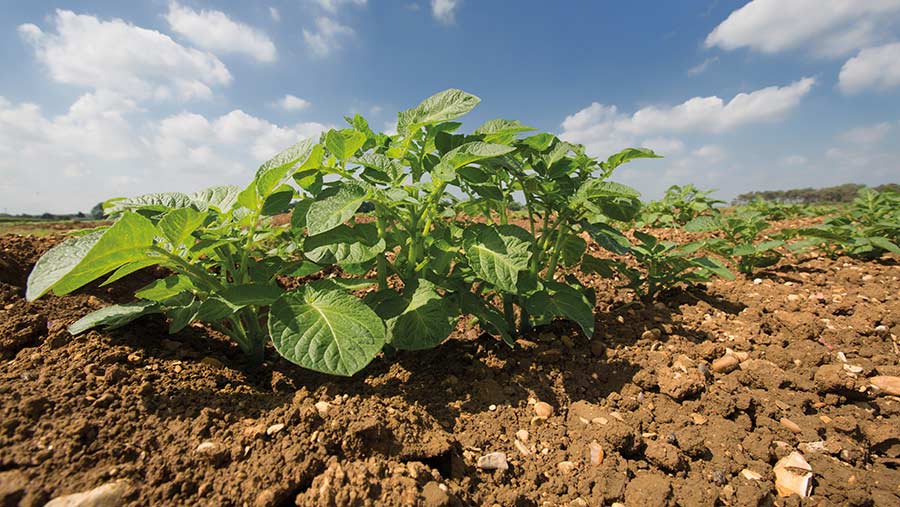Gene-edited weather-resilient potatoes may be ready by 2025
 © Tim Scrivener
© Tim Scrivener A gene-editing potato project aims to boost the rate of photosynthesis in potato crops to promote yield, water use efficiency and drought tolerance.
The initiative, known as PhotoBoost, sets it sights on a 20-25% increase in photosynthetic performance, which could lead to a 30% increase in plant biomass.
See also: How to keep potato crops free from weeds this spring
The EU-funded project draws on a range of genetic engineering disciplines and focuses on six key points to improve C3 photosynthetic performance in potatoes:
- Optimise light reaction efficiency
- Engineer a photorespiratory bypass
- Integrate algal carbon dioxide concentration mechanisms
- Optimise source-sink capacity
- Improve water-use efficiency
- Integrate an oxygen scavenging mechanism
Gene-editing in practice
Jonathan Menary, social scientist at the University of Oxford, sets out the timeline for breeders to take commercial lines of potato forward as soon as 2025.
Dr Menary continues that by combining two or more biotechnology strategies, scientists have seen rates of photosynthesis increase by at least 20-25%.
“Potatoes are C3 crops, so in certain light conditions a process called photoprotection begins, which limits photosynthesis.
“When conditions change, the plant cannot recover quickly. By genetically editing crops we can overcome this problem, overexpressing certain enzymes to reduce photoprotection and speed up recovery.”
Reducing photorespiration
Another way to optimise photosynthesis is to avoid a process called photorespiration. The enzyme Rubisco is responsible for fixing carbon dioxide and converting it into sugars.
“However, in C3 plants, up to 30% of the time Rubisco is reacting with oxygen rather than carbon dioxide.
“In the early atmosphere there was little oxygen, so plants were not affected by photorespiration. As early photosynthesisers pumped oxygen into the atmosphere, levels slowly increased,” he says.
Photorespiration costs the plant energy, which is why PhotoBoost intends to use the following genetic tools to overcome this:
Gene editing
This technique can “knock out” and remove target genes that code for certain enzymes responsible for transporting non-target substances.
This process involves precise changes to an organism’s genome, using techniques such as CRISPR-Cas 9. No foreign DNA is introduced.
Therefore, the method is likely to not be regulated as genetically modified organisms (GMOs) in England once the precision breeding bill is introduced. However, regulation could be different in Scotland.
Agrobacterium transgenics
Cyanobacteria are bacteria that obtain energy via photosynthesis. “Introducing certain cyanobacteria genes into a crop genome can reduce rates of photorespiration,” explains Dr Menary.
However, transgenics involves the modification of an organism using foreign DNA and will consequently be regulated as a GMO in the UK and European Union.
This means PhotoBoost potato products will be classified as a GMO as they contain foreign DNA.
The projects aims to exploit the latest genetic tools and knowledge about photosynthesis, but this approach could be useful for more than potatoes and rice – the two main PhotoBoost crops.
Discreet photosynthetic improvements could be licensed for different crops, depending on local needs and biotechnology regulation.
Have your say
The introduction of genetically modified organsims remains hugely controversial.
The PhotoBoost project aims to engage with a range of stakeholders to facilitate the evaluation and decision-making process for the adoption of new agricultural technology developments.
A variety of grower and wider industry focus groups are taking place. If you want to have your say, get in touch with Jonathan Menary by contacting jonathan.menary@ndm.ac.ox.uk

